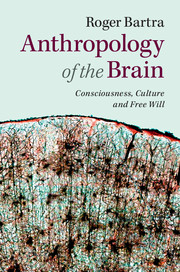Book contents
- Frontmatter
- Contents
- Preface
- Part I Consciousness and symbolic systems
- 1 The hypothesis
- 2 Evolution of the brain
- 3 Brain plasticity
- 4 Is there an internal language?
- 5 Amputations and supputations
- 6 The atrophied exocerebrum
- 7 The symbolic substitution system
- 8 Neuronal mirrors
- 9 Consciousness within hand’s reach
- 10 Outside and inside: the immense blue
- 11 The musical spheres of consciousness
- 12 Artificial memory
- 13 The lost soul
- Part II Brain and free will
- Bibliography
- Index
10 - Outside and inside: the immense blue
Published online by Cambridge University Press: 05 June 2014
- Frontmatter
- Contents
- Preface
- Part I Consciousness and symbolic systems
- 1 The hypothesis
- 2 Evolution of the brain
- 3 Brain plasticity
- 4 Is there an internal language?
- 5 Amputations and supputations
- 6 The atrophied exocerebrum
- 7 The symbolic substitution system
- 8 Neuronal mirrors
- 9 Consciousness within hand’s reach
- 10 Outside and inside: the immense blue
- 11 The musical spheres of consciousness
- 12 Artificial memory
- 13 The lost soul
- Part II Brain and free will
- Bibliography
- Index
Summary
In order to understand the relationship between exocerebral networks and neuronal circuits that operate through electrical and chemical signals, apparently it is necessary to find certain devices that connect the internal and external sequences. The first difficulty we run into is in the separation itself of the internal and the external. Two important interpretations of mental processes have been developed, but each one emphasizes the opposite sphere. First of all, we have the so-called “internalist” view that states that consciousness is a process determined by certain types of internal brain activity in individuals during the process of their interaction with the world. In contrast, the “externalist” view says that consciousness is a construct that depends on language-based social and cultural relations. The first view tends to be innatist and maintains that cognitive structures are genetically determined brain devices. It is the view held by Noam Chomsky and Jerry Fodor. At the other extreme we find authors such as Clifford Geertz and Richard Lewontin who emphasize the decisive importance of interaction and the symbolic system. I do not wish to examine this polemic because, among other reasons, it seems to me to be a confrontation that has long been surpassed, much like the opposition between nature and culture.
But not all neuroscientists, deep down, are convinced that the nature/culture opposition has been overcome, because that means accepting that the mind and consciousness go beyond the cranial and epidermal borders defining the individual. And for many, accepting that would be the equivalent of validating the “externalist” view. Recently Robert Wilson, known for his reflections on the cognitive sciences, has dedicated an interesting book to the problem of the boundaries of the mind. Wilson is convinced that the mind does not come to a stop in front of the walls that separate the individual from the external world, and presents a hypothesis that coincides to a certain degree with the ideas I have expressed about the exocerebrum.
- Type
- Chapter
- Information
- Anthropology of the BrainConsciousness, Culture, and Free Will, pp. 71 - 80Publisher: Cambridge University PressPrint publication year: 2014

